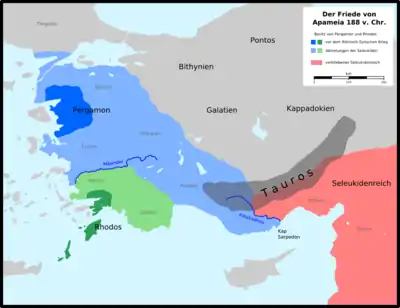Treaty of Apamea
The Treaty of Apamea was a peace treaty on 188 BC between the Roman Republic and Antiochus III, ruler of the Seleucid Empire. It took place after the Romans' victories in the Battle of Thermopylae (in 191 BC), in the Battle of Magnesia (in 190 BC) and after Roman and Rhodian naval victories over the Seleucid navy.

The treaty, according to Appian, obliged Antiochus III to abandon Europe altogether and all of Asia west of the Taurus Mountains. Also, he had to surrender all the war elephants in his possession and was limited to twelve warships for the purpose of keeping his subjects under control, but he was allowed to build more if he was attacked. Antiochus was barred from recruiting mercenaries from Roman territory and entertaining fugitives from the same. Antiochus had to give twenty hostages, whom the Roman consul would select. The hostages should be changed every third year, except the son of Antiochus. In the future, he would maintain no elephants and pay for the cost of the present war, incurred on his account, 500 Euboic talents down and 2,500 more when the Roman Senate ratified the treaty; and 12,000 more during twelve years, each yearly installment to be delivered to Rome. He was also forced to surrender all prisoners and deserters to his enemies, and to Eumenes II, the King of Pergamon, whatever remains of the possessions he acquired by his agreement with Attalus I, the father of Eumenes.
Rome gave the control of a large part of Asia Minor to Eumenes. Antiochus kept the region of Cilicia, while most of Lycia and Caria became part of the Rhodian Peraia. Hellenistic kings generally accepted, for their own lifetimes, any treaty they had signed, on the grounds of honour. On the other hand, their heirs did not feel honour bound to accept treaties signed by their predecessors. The naval conditions of the treaty appear to have fallen into abeyance, but the other conditions held.
The treaty was formalized at Apamea in Phrygia. It allowed the Romans to expand their political hegemony to the Eastern Mediterranean Sea. But at this time Roman power was still indirect, and Rome depended on its capacity to ally itself to second-rank powers.
See also
Sources
- Polybius of Megalopolis, World History, 21.42: text of the treaty
- Appian of Alexandria, Syriaca, 39: text of the treaty
- Titus Livy, Ab Urbe Condita, 38: